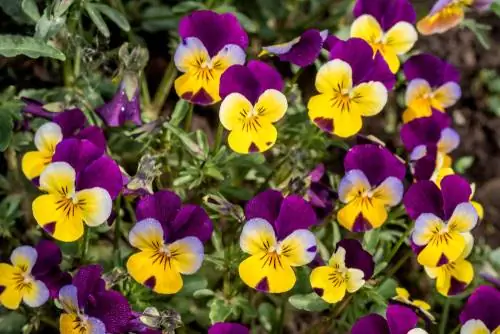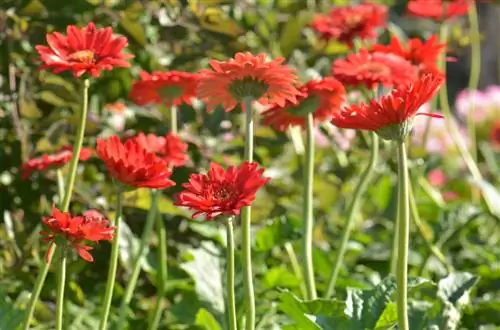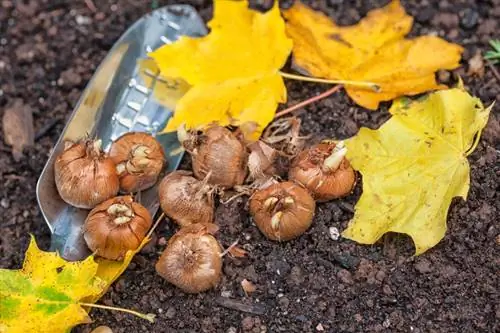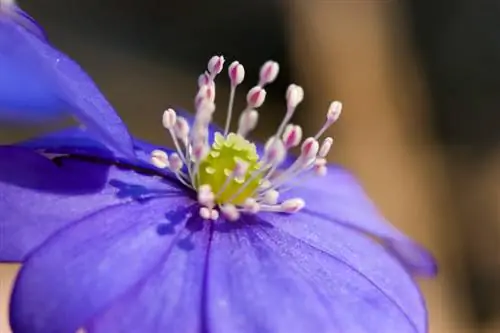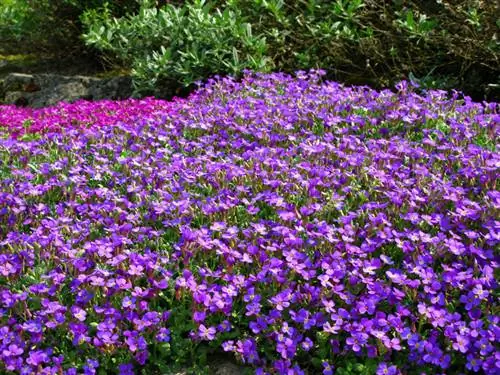- Author admin [email protected].
- Public 2023-12-25 17:45.
- Last modified 2025-01-23 11:22.
The picturesque scenery in the bed and planter is only perfect with violets. To ensure that these cheerful, colorful creatures thrive all year round, they require only a minimum of care. Find out everything you need to know about the flirty flowers here.

How to properly care for violets in the garden?
Violets are easy-care, hardy flowers that thrive in sunny to partially shaded locations. They need nutrient-rich, humus-rich soil and regular watering. It is particularly important to remove spent flowers and cut them back after the first flowering period.
Planting violets correctly
The best time to plant violas is autumn. This applies to flowers you have grown yourself as well as those you have bought ready-made. In the sun-warmed soil, the biennial plants will root in time before winter to bloom the next year. Follow these steps to do it right:
- The planting pit corresponds to 1.5 times the volume of the root ball
- Optimize the excavation with compost and horn meal or guano
- Plant Viola exactly as deep as in the nursery pot
- Press the soil and water
Depending on the type of flowers planted, a planting distance of 10 to 25 cm is considered appropriate. If you plant viola in a pot or flower box, drainage made of inorganic material prevents harmful waterlogging.read more
Care tips
Violets are a welcome guest in the ornamental and kitchen garden, as their care is limited to the following aspects:
- Water regularly when dry
- Fertilize repeatedly with compost and horn shavings from March to October
- Immediately clean out the faded flowers to attract more flowers
- Do not cover hardy species and varieties with foil due to the risk of rot
- Violas in the pot receive light winter protection so that the root ball does not freeze
After the first bloom, cut the flowers back by half and diligently sprout them again. If the location is too humid or in warm, humid weather, violas are susceptible to powdery mildew. Therefore, avoid overhead irrigation and ensure that the planting distance is airy. Since flowers are at the top of the menu for snails, the bed should be surrounded with a barrier or a snail fence.
Which location is suitable?
Viola's frugality is already evident in the choice of location, because here the flowers demonstrate a pleasant flexibility. These criteria are important:
- Sunny to semi-shady location
- Happy to provide shade in the protection of tall deciduous trees or perennials
- Nutritious, humus-rich, fresh, moist to moderately dry soil
read more
When is flowering time?
If you cleverly combine the types and varieties of violets, you will be smiled at by the lovely faces all year round. The main flowering times of the dominant species at a glance:
- Wild Pansy: March to October
- Horn Violet: April to August/September
- Scented violets: March to June
- Whitsun violets: April to June/July
- Winter violets: December to May
Consistently cleaning out withered plant parts and pruning after the first flowering has a beneficial effect on the duration of the flowering period.read more
Propagate violets
Violas ensure plenty of offspring on their own by diligently sowing themselves and sending out runners. In addition, ants carry the seeds with them. To specifically propagate the flowers, you can choose from these methods:
- Dividing the root balls in autumn or spring
- Cut off the top cuttings in summer and plant them in lean substrate
- Cut off runners as they grow and let them root in the pot
- After flowering, harvest and sow the ripe seeds
read more
Is violet poisonous?
Violets pose no he alth risk to humans or animals. On the contrary, the fragrant violet in particular serves as a medicinal and culinary plant. The colorful petals can be eaten without hesitation. The roots, however, should be treated with caution, as they were used as an emetic in folk medicine.read more
The Violet: A Profile
Looking at the profile, hobby gardeners can find out useful details for the successful cultivation of violets as well as their diverse uses. Interesting attributes include:
- Mostly biennial flowers
- Formation of underground rhizomes as a survival organ
- Growth height from 10 to 30 cm
- Species suitable for all locations
- Summergreen and wintergreen flowers
- Some species can be used as medicinal and kitchen plants
Thanks to the rhizomes, most violets have sufficient winter hardiness. Since above-ground runners thrive at the same time, the flowers themselves conquer large areas within a short time.read more
Pansies and violets: what's the difference?
Pansies and violets look very similar at first glance. In reality, every pansy is a violet, while not every violet is a pansy. Violets represent the plant genus Viola with more than 500 species. As a result of repeated crossings within these species, the pansy with its countless color variations was created.read more
The violet as a houseplant
Violas are not considered the classic houseplant. Regardless, there is nothing wrong with cultivating on the windowsill. The distinctive flowers decorate the house with their colorful blossoms primarily during the cold season. How to care for viola in a pot:
- Place on a bright south, east or west window
- Commercial potting soil as substrate
- Water regularly
- Fertilize liquidly every 14 days during the growing season
An ideal candidate is the non-hardy Australian violet, which blooms from April to September. Another option is the Parma violet, which presents its delicate porcelain flowers behind glass from November to April. The African violets, which are popular as houseplants, belong to a different genus, as do cyclamens.read more
Are violets edible?
Primarily the petals of fragrant violets, horned violets and pansies are edible. The flowers serve as an aromatic decoration on salads or candied as a sweet temptation. In addition, Viola make refreshing drinks and rich syrups. If you like, you can use violets to make he althy honey or delicious jam. The list of tempting recipes is endless and offers plenty of scope for your own creations.read more
The healing properties of violets
The violet species Viola odorata, also called fragrant violet or March violet, has been used in folk medicine for generations. In 2007, these flowers were even named medicinal plant of the year. This honor is based on the following healing effect:
- Reducing elevated blood lipid levels
- Relief from hypertension
- Antibacterial effect
- Healing for coughs and angina
read more
Sowing violet seeds
Violet seeds are cold germinators. Therefore, a cold stimulus is required for the cotyledons to appear. Sow the seeds in seed trays or the cold box between October and January. Alternatively, fill the seeds with moist sand into a plastic bag and store it in the vegetable compartment of the refrigerator for 4-6 weeks. The germinating seeds are then further treated as light germinators in the known process.read more
Are violets hardy?
The majority of violets are hardy. In severe frost, violas freeze back, but sprout again in spring. It is important to remember to water the flowers on frost-free days as long as there is no snow. To ensure that violas in the planter get through the cold season well, the pot should be thickly wrapped in bubble wrap and placed on wood or Styrofoam.read more
Fighting violets in the lawn
Violas are not always welcome in the garden. Due to their natural urge to spread, the flowers sometimes prove to be troublemakers. If violets appear in the lawn, we try to get rid of them. How to solve the problem:
- Pull individual specimens out of the lawn with a weed cutter before seeding
- Do not leave any roots or runners in the green area
- Dig out larger areas of vegetation with a spade in order to repair the gaps with turf or reseeding
- If the lawn is spreading over a large area, mow it briefly and scarify it
If violas prove to be particularly stubborn in the lawn, lawn weed killer (€109.00 at Amazon) will get rid of the problem. Proven preparations are: Banval M from Compo or Anicel Ultra from Celaflor.read more
Violets bloom in these colors
The violet was the inspiration for the classification of colors in the RGB color space. When we talk about violet, the designers of media of all types follow the instructions provided by these flowers. However, this does not mean that viola is limited to the color violet. In fact, the color spectrum extends across all conceivable tones and nuances.read more
Types of violets
The richly populated plant genus presents us with more than 500 species of violets, which have won the hearts of hobby gardeners around the globe. The most beautiful representatives of these cheerfully colorful and frugal cosmopolitans are known by these names:
- Wild pansy (Viola tricolor): the robust wild species blooms in yellow, violet-blue and white
- Horn violet (Viola cornuta): multi-flowered flowers with a height of 10-25 cm
- Scented violets (Viola odorata): bloom predominantly in violet and spread a sweet scent
- Pentecost violet (Viola sororia): the porcelain blue flowers thrive excellently as ground cover
- Parma violet (Viola suavis): blooms under glass all winter long and smells pleasant
- Stone violet (Viola rupestris): the ideal type of violet for poor soils, such as rock gardens or gravel beds
The ever-popular garden pansies (Viola × wittrockiana), however, are not a pure species. The colorful flowers result from countless crossings of the wild pansy with other violets. With the robust field pansy (Viola arvensis) or the slender long-spur pansy (Viola calcarata) we encounter one of the diverse species.read more
The most beautiful varieties
- Etain: enchanting horned violet in light yellow with violet flower edges; ideal for the rock garden
- Rebecca: a marbled horned violet in cream and purple with a petite 10 cm height
- Baronne Alice de Rothschild: the historic scented violet from 1894 impresses with purple-violet flowers
- Albiflora: the white Pentecost violet impresses with its vital vigor and serves as a magnificent ground cover
- Comte de Brazza: the lush double Parma violet blooms non-stop from March to May
- Queen Charlotte: the fragrant variety delights us with two blooms in March/April and September/October
- Ice Babies: as winter violets, the small variety family blooms in many colors from October until well into May
- Grandessa: distinctive pansies with large flowers in bright blue, red, purple or yellow and dark eyes
- Orchid-flowered: fantastically beautiful pansies with frilly flowers from September to December

